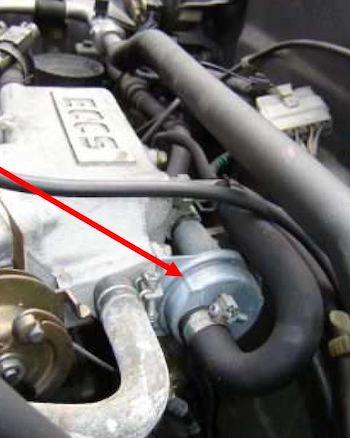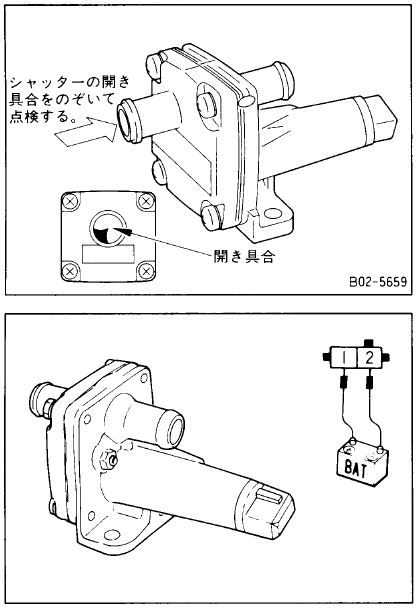Starting – How To Test The Cold Start Valve

The valve is located at the back of the engine on the ECCS as below.
What does the Cold Start Valve do?
The cold start valve allows more air into the engine when it’s cold to aid first starting which increases the idle speed. The valve closes after a few minutes once warm.
It has a bi-metal heated spring that opens and closes a valve. The documentation calls it a shutter.
The valve is literally just a dumb heater that gets +12V on one side, ground on the other, and that makes a bimetallic coil expand, rotating a little shutter to allow extra air past it or not.
Symptoms of it failing are that the car stalls straight after starting and requires additional throttle till warm. This is now a common issue due to age and lack of maintenance.
Note: If there are idle issues once warm then it isn’t this and you should check the IAA setup see the link here
The unit can still be purchased from eBay or Parts supplier Amayama.

The Nissan Part Number: is 22660-17B65 you can still buy these new, cheapest from here or order from your local Nissan dealer or direct from Japan from here
If removing be VERY careful as the bolts seize and can shear off I would suggest using penetrating fluid and perhaps when warm and work them out slowly by undoing slightly and then re-tightening slightly and continuing till it comes out. When refitting do not over tighten!
If they do shear off they will then will require drilling out and re-tapping a thread which is extremely difficult in situ and may require the inlet manifold and ECCS to be removed in one piece, be aware that the joint gasket is no longer available, the only one is available is the one between the engine and intake manifold Part Number: 1403519B25.
However, you can buy gasket paper and make your own if you are really stuck.
 Testing
Testing
You can do the first test in situate to make sure that the heater coil isn’t shorted or open. Just like it says on the plug terminal, 80 ohms is the spec for resistance, just unplug the connector and check using a multimeter set to resistance ohms
If this is OK the next check is to see if the shutter moves. If you disconnect the rubber pipe attached you can see into the valve. If you look into the end of the regulator you can see the shutter. It again may be possible to do this in situ.
The manual states:
- At -20C the shutter is fully open
- At 20C the shutter is about half open
- At 60C the shutter is fully closed
Below shows it when cold and the valve is slightly open. If it’s not cold you could put the valve in the freezer for about five to ten minutes which should open it.

 If you then put power to it. It doesn’t matter which terminal sees 12V and which is ground. This can be done using two wires from the battery, just be absolutely sure not to let the ends of your test leads touch because a car battery can serve up enough amps to do some arc welding!
If you then put power to it. It doesn’t matter which terminal sees 12V and which is ground. This can be done using two wires from the battery, just be absolutely sure not to let the ends of your test leads touch because a car battery can serve up enough amps to do some arc welding!
If however, you have an adjustable power supply, you can feed it 14.5V, which is where the car’s system voltage should be around with the alternator charging.
This will energize the heater coil inside the valve and make the bimetallic strip expand, rotating the shutter.
Below after about seven minutes. You can see how the shutter rotated closed, blocking off bypass air. If yours doesn’t do this, it likely needs to be replaced. It’s worth noting that mine was absolutely stuffed with oily gunk, and spraying it full of aerosol carburettor cleaner and letting it sit for a while before dumping flushed out all manner of nastiness.

Below is a diagram from the original Nissan Figaro Manual. The 2 tests in the table on page 120 of the EF-EC.

Read/Download PDF Click here









